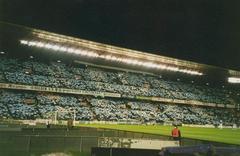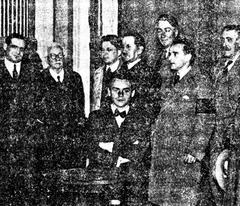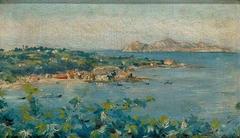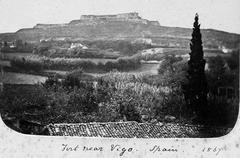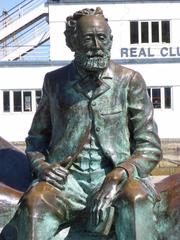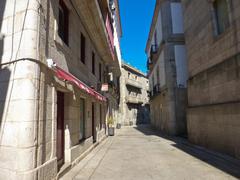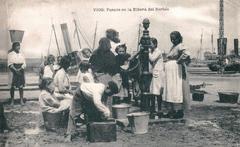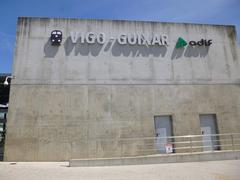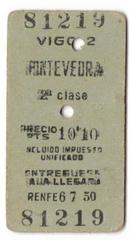
Edificio Curbera Visiting Hours, Tickets, and Guide to Vigo Historical Sites
Date: 04/07/2025
Introduction to Edificio Curbera and Its Significance in Vigo
Edificio Curbera stands as an architectural icon in Vigo, reflecting the city’s transformation from a traditional Galician fishing port to a dynamic urban and economic center in the 20th century. Commissioned by the influential Curbera family, the building’s strategic location at Avenida de García Barbón 30 in the heart of the Ensanche district anchored Vigo’s modern skyline. As one of the earliest skyscrapers in Galicia, Edificio Curbera symbolizes Vigo’s aspirations toward modernization and commercial growth (Vigo Histórico; Docomomo Ibérico).
Architecturally, Edificio Curbera bridges French Beaux-Arts, Spanish Modernismo, and the Rationalist movement, showcasing decorative stonework, wrought iron balconies, and a geometric, functionalist design executed by Francisco Castro Represas. The use of reinforced concrete and Galician granite not only exemplifies technical innovation but also roots the building in local identity (Galicia Digital; Patrimonio Galego). While interior access is restricted due to its mixed-use function, the building’s commanding façade—visible from the bustling commercial district—remains a highlight for architecture enthusiasts. Guided walking tours frequently include Edificio Curbera, offering visitors historical context and expert interpretation (Turismo de Vigo; Ayuntamiento de Vigo).
Beyond its architectural importance, Edificio Curbera serves as a gateway to Vigo’s cultural attractions, including Casco Vello, Parque de Castrelos, the Ría de Vigo waterfront, and museums such as MARCO. The surrounding district brims with dining, shopping, and cultural activities, making Edificio Curbera an essential stop for visitors exploring Vigo’s rich urban landscape (The Tourist Checklist; Best Things To Do in Vigo).
Table of Contents
- Origins and Historical Context of Edificio Curbera
- Architectural Significance and Urban Identity
- Role in Vigo’s Urban Development
- Social and Economic Impact
- Preservation, Adaptive Reuse, and Visitor Information
- Architectural Style: Rationalism and Modernity
- Structural Innovations and Materials
- Façade Design and Decorative Features
- Urban Visibility and Symbolism
- Practical Visitor Information
- Visitor Tips and Nearby Attractions
- Exploring the Cultural Landscape Around Edificio Curbera
- Visitor Recommendations and Best Times to Visit
- Notable Nearby Attractions
- Summary Table: Key Attractions Near Edificio Curbera
- Sustainability and Responsible Tourism
- Safety and Visitor Etiquette
- Conclusion and Recommendations
- Sources and Further Reading
Origins and Historical Context of Edificio Curbera
Constructed during Vigo’s industrial boom, Edificio Curbera reflects the city’s rapid urban and economic expansion in the first half of the 20th century. The Curbera family’s investment in a modern, mixed-use structure along the city’s most prestigious avenue demonstrated Vigo’s cosmopolitan ambitions (Concello de Vigo). Its presence contributed to the transformation of Policarpo Sanz and García Barbón into Vigo’s financial and cultural arteries, marked by elegant architecture and new infrastructure.
Architectural Significance and Urban Identity
Designed by Francisco Castro Represas, a prominent figure in Galician Rationalism, Edificio Curbera fuses geometric clarity, minimal ornamentation, and functional zoning. The building’s symmetrical façade, vertical emphasis, and use of Galician granite embody both the Rationalist aesthetic and a sense of local identity (Galicia Digital; Patrimonio Galego).
Role in Vigo’s Urban Development
As one of the first true “skyscrapers” in Vigo, Edificio Curbera set a precedent for vertical development in the city. Its mixed-use model—commercial spaces at street level and residences above—aligned with early 20th-century trends in European urban planning (Vigo Arquitectura). The building catalyzed further investment in the area, attracting banks, theaters, and luxury shops, and fostering a vibrant urban core (Vigo City Council).
Social and Economic Impact
Edificio Curbera quickly became a social focal point, with ground-floor boutiques and cafés frequented by Vigo’s burgeoning middle class and cultural elite. The building’s success influenced the gentrification and modernization of the Ensanche district, reinforcing its status as a symbol of Vigo’s upward mobility (La Voz de Galicia).
Preservation, Adaptive Reuse, and Visitor Information
Recognized as a protected heritage site, Edificio Curbera has undergone careful restoration to maintain its original features and ensure safety. The building remains in active use, housing offices, shops, and residences (Patrimonio de Vigo).
Visitor Information
- Exterior Viewing: The façade is visible to the public at all times; interior access is restricted.
- Tickets: No admission is required to view the building from the street.
- Guided Tours: Architectural walking tours often feature Edificio Curbera; bookings are available through tourism offices and online platforms.
- Accessibility: The surrounding district is pedestrian-friendly and accessible for visitors with mobility needs.
Architectural Style: Rationalism and Modernity
Design Principles
Edificio Curbera exemplifies Spanish Rationalism, prioritizing symmetry, geometric clarity, and functional organization. The building’s strong vertical axis, minimal ornamentation, and subtle Art Deco elements reflect this ethos (Wikipedia; Patrimonio Galego).
Key Features
- Symmetrical façade with a central vertical granite band.
- Minimal decorative elements, except at the entrance and cornice.
- Functional zoning with unified exterior design, masking the internal division between commercial and residential uses (Ayuntamiento de Vigo).
Structural Innovations and Materials
The use of reinforced concrete allowed Edificio Curbera to rise 13 stories (50 meters), a remarkable feat at the time. The granite façade not only ensured durability but also anchored the building in the Galician landscape (Farodevigo).
Façade Design and Decorative Features
- Base and Mezzanine: Robust granite base with commercial spaces; a continuous horizontal mezzanine window provides light to offices.
- Central Axis: Accentuated by darker granite, reinforcing the building’s verticality.
- Balconies and Windows: Rhythmic horizontal bands; curved balconies with metal railings and cylindrical supports.
- Cornice and Art Deco Motifs: Stepped triangular pediment and granite slabs evoke Art Deco influences and break the strict rationalist lines (Wikipedia).
Urban Visibility and Symbolism
Situated on Avenida de García Barbón, Edificio Curbera’s silhouette once dominated Vigo’s skyline, symbolizing the city’s leap into modernity. Although neighboring high-rises have since reduced its visual dominance, the building remains a reference point in Vigo’s architectural heritage (Docomomo Ibérico; Ayuntamiento de Vigo).
Practical Visitor Information
- Location: Avenida de García Barbón 30 (Google Maps)
- Hours: Exterior viewable 24/7; ground-floor businesses open during standard hours.
- Tickets: Not required for exterior viewing.
- Accessibility: Pedestrian area with accessible sidewalks.
- COVID-19 Guidelines: Follow local health regulations.
Visitor Tips and Nearby Attractions
- Best Viewing: Cross Avenida de García Barbón for unobstructed photos, especially in late afternoon light.
- Transportation: Easily accessible by bus, train (Vialia Vigo station), and taxi.
- Dining: Enjoy nearby cafés, tapas bars, and seafood restaurants.
- Tourist Info: Local Tourist Information Office is open daily for maps and guidance (Turismo de Vigo).
Exploring the Cultural Landscape Around Edificio Curbera
Casco Vello (Old Town)
Wander through Vigo’s historic heart, discovering narrow streets, artisan shops, and Galician taverns (Best Things To Do in Vigo).
Parque de Castrelos
A vast green park featuring gardens and the Pazo de Castrelos museum, ideal for relaxation and cultural exploration.
Ría de Vigo and Waterfront Promenade
Stroll along the waterfront for panoramic bay views, maritime ambiance, and fresh seafood at Mercado da Pedra (The Tourist Checklist).
Bouzas Neighborhood
Experience the charm of Vigo’s old fishing district, with its tranquil streets, small harbor, and celebrated seafood restaurants.
MARCO (Museo de Arte Contemporáneo de Vigo)
Explore contemporary art exhibitions in a striking former courthouse building (Spain.info).
Visitor Recommendations and Best Times to Visit
- When to Visit: Spring (April–June) and early autumn (September–October) offer mild weather and active cultural events (Spain.info). July is ideal for outdoor activities, with long daylight hours and minimal rainfall.
- Attire: Light clothing and comfortable shoes recommended for city exploration.
- Language: Spanish and Galician are spoken; English is widely understood in tourist areas.
- Safety: Vigo is generally safe; basic precautions are advised.
Notable Nearby Attractions
| Attraction | Distance | Highlights |
|---|---|---|
| Casco Vello (Old Town) | ~500 m | Historic streets, local cuisine, artisan shops |
| Parque de Castrelos | ~3 km | Gardens, museum, concerts |
| Ría de Vigo Waterfront | ~800 m | Scenic views, maritime ambiance |
| Mercado da Pedra | ~1 km | Fresh seafood, local market |
| Bouzas Neighborhood | ~4 km | Fishing village, promenade, seafood restaurants |
| Mount Castro | ~1.5 km | Panoramic views, Celtic ruins |
| Cíes Islands (by ferry) | Ferry | Beaches, hiking, nature reserve |
| MARCO Museum | ~1 km | Contemporary art exhibitions |
Sustainability and Responsible Tourism
Support local businesses, use public transportation, and respect Vigo’s architectural heritage. Many local cafés practice sustainability; recycling bins are widely available.
Safety and Visitor Etiquette
Maintain vigilance over personal belongings in busy areas, greet locals in Spanish or Galician, and observe dress codes in religious or formal settings. Smoking is permitted outdoors but not indoors.
Conclusion and Recommendations
Edificio Curbera is a cornerstone of Vigo’s architectural narrative and urban identity. Though interior access is restricted, its striking façade, central location, and role in local history make it a must-see for any visitor. Pair your visit with nearby sites, guided tours, and local cuisine for a complete experience of Vigo’s vibrant culture.
For updated maps, events, and personalized recommendations, visit the Tourist Information Office or download the Audiala app for curated tours and insider tips.
Sources and Further Reading
- Vigo Histórico – Edificio Curbera
- Concello de Vigo Urbanismo
- Galicia Digital – Edificio Curbera
- Vigo Arquitectura
- La Voz de Galicia Article
- Patrimonio de Vigo
- Turismo de Vigo
- Google Maps – Edificio Curbera
- Wikipedia – Edificio Curbera
- Docomomo Ibérico – Edificio Curbera
- Patrimonio Galego – Edificio Curbera
- Best Things To Do in Vigo
- Tourist Places Guide
- The Tourist Checklist
- Spain.info
- Ayuntamiento de Vigo Architectural Routes

